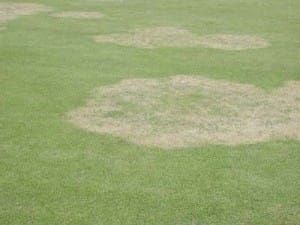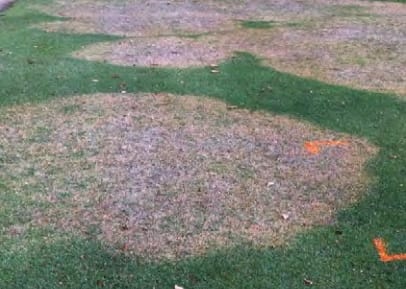
Alfredo Martinez, Extension Plant Pathologist
Large patch disease of turfgrass is most common in the fall and in the spring as warm season grasses are entering or leaving dormancy. Large patch is caused by the fungus Rhizoctonia solani. It can affect zoysia grass, centipedegrass, St. Augustinegrass and occasionally bermudagrass.
Symptoms of this lawn disease include irregularly-shaped weak or dead patches that are from 2 feet to up to 10 feet in diameter. Inside the patch, you can easily see brown sunken areas. On the edge of the patch, a bright yellow to orange halo is frequently associated with recently affected leaves and crowns. The fungus attacks the leaf sheaths near the thatch layer of the turfgrass.
Large patch disease is favored by:
- Thick thatch
- Excess soil moisture and poor drainage
- Too much shade which stresses turfgrass and increases moisture on turfgrass leaves and soil
- Early spring and late fall fertilization.
If large patch was diagnosed earlier, fall is the time to control it with fungicides. Consult the Pest Management Handbook , Turfgrass Pest Control Recommendations for Professionals or your local Extension Office for fungicide recommendations. Fall fungicide applications may make treating in the spring unnecessary. Always follow label instructions, recommendations, restrictions and proper handling when applying pesticides.
Cultural practices are very important in control. Without improving cultural practices, you may not achieve long term control.
- Use low to moderate amounts of nitrogen, moderate amounts of phosphorous and moderate to high amounts of potash. Avoid applying nitrogen when the disease is active.
- Avoid applying N fertilizer before May in Georgia. Early nitrogen applications (March-April) can encourage large patch.
- Water timely and deeply (after midnight and before 10 AM). Avoid frequent light irrigation. Allow time during the day for the turf to dry before watering again.
- Prune, thin or remove shrub and tree barriers that contribute to shade and poor air circulation. These can contribute to disease.
- Reduce thatch if it is more than 1 inch thick.
- Increase the height of cut.
- Improve the soil drainage of the turf.
- Apply lime if soil pH is acidic (i.e. less than 6.0 – except on centipede lawns). Soil pH of more than 6.5 can encourage take all infections.
See the current Georgia Pest Management Handbook for more information. Check fungicide labels for specific instructions, restrictions, special rates, recommendations and proper follow up and handling.
Additional resources:
Turfgrass Diseases in Georgia or Enfermedades de los céspedes en Georgia
Turfgrass Diseases: Quick Reference Guide or Enfermedades de Cespedes Guia de Referencia Rapida
